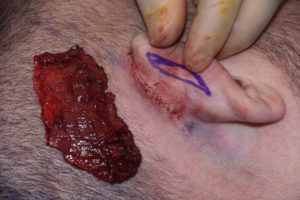Temporal reduction is an aesthetic procedure that is used for the treatment of the ‘wide head’ or undesired convexity to the side of the head above the ears. It is a muscle removal procedure since the posterior temporal muscle belly makes up a greater percentage of the width of the head in this area that one would think. While it may just a normal head development that someone wants changed or due to an overly big or overdeveloped temporal muscle, the effectiveness of temporal reduction surgery at bringing in the sides of the head and making it straighter is undeniable.
The wider head may also be associated with or create an excessive ear protrusion. It is easy to see how the upper part of the ear could be pushed out as a result of displacement of the muscle width. And in some patients even with normally positioned ears, narrowing the side of the head above it can potentially make the ears appear more protrusive with shape change above it. As a result there is always the consideration of the need for setting back the ears (setback otoplasty) either during or after temporal reduction surgery.


Temporal reduction and otoplasty can be successfully performed together and collectively provides a powerful reshaping result to the side of the head.
Dr. Barry Eppley
Indianapolis, Indiana


